21.11.2018

In the sci-fi franchise “Star Trek,” the U.S.S. Enterprise zips back and forth across the universe, propelled by a “warp drive.” Sadly for fans of space travel, that would seem to run counter to Einstein’s equations, which generally prohibit faster-than-light journeys.
But with the hypothetical addition “exotic matter,” this sci-fi invention actually fits within the confines of Einstein’s theory of general relativity, which describes gravity and the bending of space-time by matter.
And so physicists have been calculating and debating, to no conclusion, whether such a device could be built and used to travel to the stars.
Back in 1994, Miguel Alcubierre was a physics graduate student at Cardiff University in Britain. “I was watching ‘Star Trek’,” he recalled last year in a talk at Starship Congress 2017. (Yes, there are scientific conferences about how to build starships.)
“It got me to thinking,” Dr. Alcubierre said, “if there was any way in which you could come up with a geometry of space-time that was similar to this idea of warp drive in science fiction that allowed you to travel faster than light.”
While general relativity’s equations can be easily written down, they are impossible to solve, except in a few special situations.
What Dr. Alcubierre, now director of the Nuclear Sciences Institute at the National Autonomous University of Mexico, did was to construct a special solution to the general relativity equations that described a “warp bubble.”
The bubble would scrunch space in front and expand it in back, and a starship within the bubble would appear to move at a speed faster-than-light even though it remains stationary.
For example, Alpha Centauri, the nearest neighboring star system, is 4.4 light-years away. Put a starship in a warp bubble. Shrink the distance in front of the starship to a couple of inches, expand the space behind it to 4.4 light-years and then pop the starship out of the bubble.
Voilà! The starship arrives at Alpha Centauri, in less than the 4.4 years it would take a beam of light to travel that distance.
Dr. Alcubierre likened the concept to a moving walkway in an airport. “You just stand there and you move,” he said. “You don’t have to walk. It just pushes you along.”
The key is that relativity does not impose a speed limit on the expansion of space. “Space can expand at any speed it wants,” Dr. Alcubierre said.
The biggest missing piece is that distorting space-time as described by Dr. Alcubierre requires something not known to exist: matter with an energy density less than zero. All known matter — stars, rocks, hot dogs, people and everything else — has a positive energy density, a consequence of E=mc².
Normal gravity contracts space. Negative energy has the effect of antigravity, pushing space apart, which you would need for the aspect of the warp drive that expands space.
Physics does not rule out the possibility that negative energy density can exist. Some have proposed that the Casimir effect — a strange but demonstrated phenomenon of quantum mechanics in which an empty vacuum can generate electromagnetic forces to pull objects toward one another — could be employed to generate a negative energy density.
Even if it could be done, early calculations indicated that a warp drive would require an impossibly gargantuan amount of energy — more energy than exists in the universe. Physicists later whittled that down to more modest but still impractical amount: the equivalent of the mass of Jupiter, converted to energy.
Many additional shortcomings would have to be solved. Other issues that physicists have debated include:
-
How much energy would be needed to bend space?
-
Do space-time warping devices have to deployed more like a railroad along the path ahead of the starship to make it work?
-
Could the crew steer the warp bubble?
-
Would coming out of warp create the equivalent of a sonic boom that would destroy the destination?
If faster-than-light travel were possible, it could also be employed for time travel. That would violate another cherished notion of physics: causality, the notion that the future cannot change the past.
A warp drive could turn out to be a momentary scientific mirage. As scientists further unravel the fundamental laws that govern the universe, they may discern a principle that proves it to be impossible.
Nonetheless, some NASA scientists led by Harold G. White, a physicist at the Johnson Space Center in Houston, have played around with the concept. They say they have found a way to configure the hypothetical negative energy matter so that the warping could be accomplished with a mass equivalent to the Voyager spacecraft.
“What this does is it moves the idea from the category of completely impossible to maybe plausible,” said Dr. White in a talk at NASA’s Ames Research Center in 2014. “It doesn’t say anything about feasible. And so, unfortunately, that point usually gets missed a lot.”
